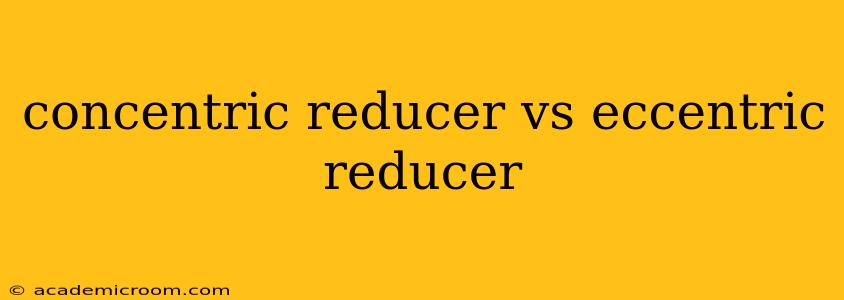Pipe reducers are essential components in piping systems, facilitating the smooth transition between pipes of different diameters. Understanding the differences between concentric and eccentric reducers is crucial for selecting the appropriate fitting for your specific application. This article will delve into the key distinctions, highlighting their respective advantages and disadvantages to help you make an informed decision.
What is a Concentric Reducer?
A concentric reducer is a pipe fitting where the centerlines of the inlet and outlet pipes are aligned. This means the smaller diameter pipe is positioned directly in the center of the larger diameter pipe. This creates a symmetrical reduction in pipe size.
Advantages of Concentric Reducers:
- Simplicity: Their simple design makes them easy to install and understand.
- Symmetrical Flow: The symmetrical reduction minimizes flow disturbances and turbulence, resulting in smoother fluid flow. This is especially beneficial for applications with sensitive fluids or where minimizing pressure loss is critical.
- Cost-Effective: Generally, concentric reducers are less expensive than eccentric reducers.
Disadvantages of Concentric Reducers:
- Sediment Accumulation: In applications carrying liquids with sediment, the concentric design can lead to sediment build-up at the bottom of the smaller pipe, potentially causing blockages or restricting flow.
What is an Eccentric Reducer?
An eccentric reducer, on the other hand, features misaligned centerlines of the inlet and outlet pipes. The smaller diameter pipe is offset, typically positioned at the top or bottom of the larger diameter pipe. This offset design creates an asymmetrical reduction.
Advantages of Eccentric Reducers:
- Sediment Management: The offset design prevents sediment from settling in the smaller diameter pipe. This is especially crucial for applications carrying liquids with sediment or slurries, ensuring uninterrupted flow.
- Improved Flow in Gravity Systems: In gravity-fed systems, the eccentric reducer's design ensures that the liquid flows smoothly along the top of the reducer, minimizing the chances of blockage and maximizing flow efficiency.
Disadvantages of Eccentric Reducers:
- More Complex Design: The asymmetrical design is slightly more complex to manufacture, resulting in a higher cost compared to concentric reducers.
- Potential for Increased Turbulence: While generally less problematic than sediment build-up, the asymmetric shape can, in certain applications, introduce slightly more turbulence than a concentric reducer. However, this is often negligible.
- Installation Considerations: Installation might require more careful positioning to align the eccentric offset correctly.
Concentric Reducer vs. Eccentric Reducer: Key Differences Summarized
| Feature | Concentric Reducer | Eccentric Reducer |
|---|---|---|
| Centerlines | Aligned | Misaligned |
| Sediment Handling | Prone to accumulation | Minimizes accumulation |
| Flow | Generally smoother, less turbulence | Slightly more turbulence (often negligible) |
| Cost | Typically less expensive | Typically more expensive |
| Applications | Clean liquids, high-pressure systems | Liquids with sediment, gravity systems |
What Type of Reducer Should I Use?
The choice between a concentric and eccentric reducer depends heavily on the specific application and the characteristics of the fluid being transported.
-
Use a concentric reducer for: Applications with clean liquids, high-pressure systems where minimizing pressure drop is paramount, and where sediment buildup is not a concern.
-
Use an eccentric reducer for: Applications involving liquids containing sediment or slurries, gravity-fed systems, and where maintaining consistent flow is crucial, even with the presence of solids.
How are reducers installed?
Installation procedures are similar for both types, generally involving welding or flanging. However, the eccentric reducer requires careful alignment to ensure the offset is correctly positioned for optimal functionality. Proper installation is critical for both types to prevent leaks and ensure efficient operation. Always consult relevant industry codes and best practices.
By carefully considering the advantages and disadvantages of each type, engineers and technicians can select the optimal reducer for their specific piping system, ensuring smooth, efficient, and reliable fluid transport.
